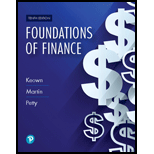
Foundations Of Finance
10th Edition
ISBN: 9780134897264
Author: KEOWN, Arthur J., Martin, John D., PETTY, J. William
Publisher: Pearson,
expand_more
expand_more
format_list_bulleted
Textbook Question
Chapter 15, Problem 6SP
(Cost of secured short-term credit) The Marlow Sales and Distribution Co. needs $1.5 million for the 3-month period ending September 30, 2015. The firm has explored two possible sources of credit.
- a. Marlow has arranged with its bank for a $1.5 million loan secured by its accounts receivable. The bank has agreed to advance Marlow 75 percent of the value of its pledged receivables at a rate of 9 percent plus a 1 percent fee based on all receivables pledged. Marlow’s receivables average a total of $1.75 million year-round.
- b. An insurance company has agreed to lend the $1.5 million at a rate of 8 percent per annum, using a loan secured by Marlow’s inventory of salad oil. A field-warehouse agreement would be used, which would cost Marlow $2,000 a month. Which source of credit should Marlow select? Explain.
Expert Solution & Answer
Trending nowThis is a popular solution!

Students have asked these similar questions
If $500 is invested at 5% interest per year, how much after 1 year?
Stock rises from $80 to $100. % Increase?A) 20% B) 25% C) 15% D) 10%
Finance question
7. A person buys a stock for $100 and sells it for $120. What is the gain?A) $10B) $20C) $25D) $15
Chapter 15 Solutions
Foundations Of Finance
Ch. 15 - Dell Computer Corporation (DELL) has long been...Ch. 15 - Prob. 2RQCh. 15 - Prob. 3RQCh. 15 - Prob. 4RQCh. 15 - Explain what is meant by the statement The use of...Ch. 15 - Prob. 6RQCh. 15 - Prob. 7RQCh. 15 - How can the formula interest = principle rate ...Ch. 15 - How can we accommodate the effects of compounding...Ch. 15 - Prob. 10RQ
Ch. 15 - Prob. 11RQCh. 15 - Prob. 12RQCh. 15 - Prob. 1SPCh. 15 - Prob. 2SPCh. 15 - Prob. 3SPCh. 15 - (Estimating the cost of bank credit) Paymaster...Ch. 15 - (Cost of short-term financing) The R. Morin...Ch. 15 - (Cost of secured short-term credit) The Marlow...Ch. 15 - (Cost of short-term financing) You plan to borrow...Ch. 15 - Prob. 8SPCh. 15 - (Cost of trade credit) Calculate the effective...Ch. 15 - (Annual percentage yield) Compute the cost of the...Ch. 15 - Prob. 11SPCh. 15 - (Cost of accounts receivable) The Michelin...Ch. 15 - (Cost of accounts receivable) The Michelin...Ch. 15 - (Cost of factoring) MDM, Inc. is considering...Ch. 15 - (Cost of factoring) A factor has agreed to lend...Ch. 15 - Prob. 16SPCh. 15 - Prob. 17SP
Knowledge Booster
Learn more about
Need a deep-dive on the concept behind this application? Look no further. Learn more about this topic, finance and related others by exploring similar questions and additional content below.Similar questions
- Finance question 7. A person buys a stock for $100 and sells it for $120. What is the gain?A) $10B) $20C) $25D) $15arrow_forwardA person buys a stock for $100 and sells it for $120. What is the gain?A) $10B) $20C) $25D) $15arrow_forwardi need help!! If you invest $1,000 at 10% compound interest for 1 year, the amount is:A) $1,100B) $1,050C) $1,200D) $1,000arrow_forward
- If you invest $1,000 at 10% compound interest for 1 year, the amount is:A) $1,100B) $1,050C) $1,200D) $1,000arrow_forwardI need help!! A loan of $5,000 at 6% interest for 2 years gives what simple interest?A) $600B) $500C) $300D) $200arrow_forwardA loan of $5,000 at 6% interest for 2 years gives what simple interest?A) $600B) $500C) $300D) $200arrow_forward
- Dear expert i need answer in this question!! What does ROI stand for in finance?A) Return on InvestmentB) Rate of InterestC) Revenue on IncomeD) Return on Insurancearrow_forwardI need help in this question!! What does ROI stand for in finance?A) Return on InvestmentB) Rate of InterestC) Revenue on IncomeD) Return on Insurancearrow_forwardI need help!! What is the full form of EMI?A) Equal Monthly IncomeB) Equated Monthly InstallmentC) Effective Money InvestmentD) Equal Money Interestarrow_forward
- No AI solution What is the full form of EMI?A) Equal Monthly IncomeB) Equated Monthly InstallmentC) Effective Money InvestmentD) Equal Money Interestarrow_forwardWhat is the full form of EMI?A) Equal Monthly IncomeB) Equated Monthly InstallmentC) Effective Money InvestmentD) Equal Money Interestarrow_forwardA higher credit score usually means:A) Lower loan approval chancesB) Better interest ratesC) No effect on creditD) More taxesarrow_forward
arrow_back_ios
SEE MORE QUESTIONS
arrow_forward_ios
Recommended textbooks for you
 EBK CONTEMPORARY FINANCIAL MANAGEMENTFinanceISBN:9781337514835Author:MOYERPublisher:CENGAGE LEARNING - CONSIGNMENT
EBK CONTEMPORARY FINANCIAL MANAGEMENTFinanceISBN:9781337514835Author:MOYERPublisher:CENGAGE LEARNING - CONSIGNMENT

EBK CONTEMPORARY FINANCIAL MANAGEMENT
Finance
ISBN:9781337514835
Author:MOYER
Publisher:CENGAGE LEARNING - CONSIGNMENT
What Does ROI (Return On Investment) Really Mean?; Author: REtipster;https://www.youtube.com/watch?v=Z6ThJvNr1Dw;License: Standard Youtube License